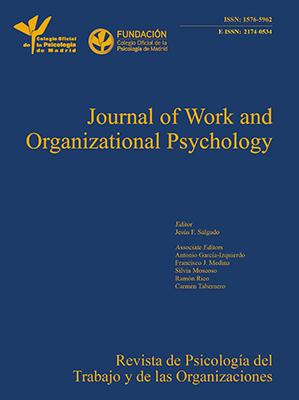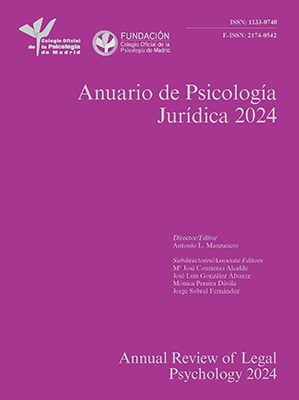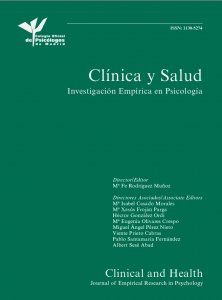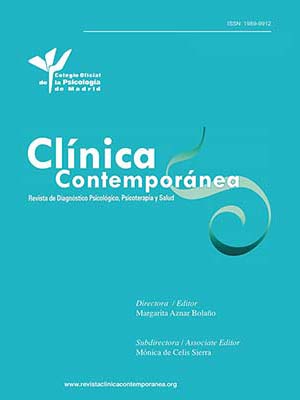
Classroom Climate: Empirical Validation and Educational Implications of a Conceptual Model. A Multilevel Study
[El clima en clase: validaciĂłn empĂrica e implicaciones educativas de un modelo conceptual. Un estudio multinivel]
Jesús Alonso-Tapia and Miguel Ruiz-Díaz
Universidad AutĂłnoma de Madrid, Spain
https://doi.org/10.5093/psed2025a19
Received 9 October 2023, Accepted 4 April 2025
Abstract
Classroom Climate (CC) is supposed to affect students’ motivation, emotions, behavior, and learning, but the existing models are not specific enough to provide a guide for analyzing and improving it. This paper aims to provide and validate a specific CC model including four components – academic-motivational, discipline, and emotional climate created by teachers’ action patterns, and co-living climate referred to as social relationships between students; 5,471 Secondary and High School students from 262 classrooms of 27 Spain and Costa Rica schools participated in the study. Structural equation modeling showed a high structural validity of the CC model. However, the co-living climate was not an indicator of CC as good as the other hypothesized components. A multilevel analysis showed that the model is similar at both levels, student and classroom. Furthermore, path analyses showed that the effects of the CC score attributed to the teacher are higher than if CC components are used as independent though combined predictors.
Resumen
Se supone que el clima de clase (CC) afecta a la motivación, las emociones, el comportamiento y el aprendizaje del alumnado, pero los modelos existentes no son lo suficientemente específicos como para proporcionar una guía para analizarlo y mejorarlo. Este trabajo busca proporcionar y validar un modelo específico de CC de cuatro componentes: clima académico-motivacional, de manejo de la disrupción y emocional, creados por los patrones de acción del profesorado, y el clima de convivencia, referido a las relaciones sociales entre el alumnado. Participaron en el estudio 5,471 estudiantes de Secundaria y Bachillerato de 262 aulas de 27 colegios de España y Costa Rica. El modelado mediante ecuaciones estructurales (MEE) puso de manifiesto una gran validez estructural del modelo de CC. Sin embargo, el clima de convivencia no fue un indicador de CC tan eficaz como los demás componentes hipotéticos. El análisis multinivel muestra que el modelo es similar en ambos niveles, de estudiante y de aula. Además, los análisis de trayectorias muestran que el efecto de la puntuación global de CC atribuida al profesorado es mayor que si los componentes de CC se utilizan como predictores independientes aunque combinados.
Palabras clave
Clima de clase, Clima motivacional, GestiĂłn de la disrupciĂłn, Clima emocional, Clima socialKeywords
Classroom climate, Motivational climate, Disruption management, Emotional climate, Social climateCite this article as: Alonso-Tapia, J. and Ruiz-Díaz, M. (2025). Classroom Climate: Empirical Validation and Educational Implications of a Conceptual Model. A Multilevel Study. PsicologĂa Educativa, 31(2), 129 - 139. https://doi.org/10.5093/psed2025a19
Correspondence: jesus.alonso@uam.es (J. Alonso-Tapia).Students are influenced not only by the individual actions of each teacher but also by the set of teaching, managing, and supporting actions deployed by them. These actions define the “classroom climate” (CC) (Ames, 1992; Bardach et al., 2020; Wang et al., 2020), a more specific way of conceptualizing the “classroom learning environment” (Alansari & Rubie-Davies, 2020; Fraser, 1998). Like the atmospheric climate, CC is the result of the interaction of a set of factors, actions and interactions that classroom members experience and share, and have cognitive, emotional, and behavioral impact. According to Evans et al. (2009), CC is a multifaceted concept, which includes different dimensions: 1) the academic-instructional climate (AIC), defined by the pedagogical and curricular factors of the learning environment. As these factors have motivational implications, some authors had previously defined it as “classroom motivational climate” (CMC) (Ames, 1992); 2) the disruption management climate (DMC), made up of the set of actions that the teacher implements for the prevention or resolution of discipline problems; and 3) the classroom emotional-interpersonal climate (CEC), defined by the interactions involved in the emotional exchanges between teachers and students. Therefore, from Evans et al.’s view the CC is mainly shaped by teachers’ actions. Several meta-analyses and systematic reviews of CC dimensions summarize the state of the art (Gage et al., 2020; Lee &Gage, 2020; Wang et al., 2020). In one meta-analysis including 61 studies Wang et al. (2020) underlined the multidimensionality of the concept and the lack of agreement about the way to conceptualize it. Nevertheless, their review has also shown that researchers highlight three essential classroom components that coincide with components pointed out by Evans et al. (2009), though sometimes they have received different names: instructional, organization-management, and socio-emotional components. The “instructional component” shows up in indicators such as the use of challenging tasks promoting critical thinking, applying knowledge to real-life scenarios, and the frequency and quality of feedback (Alonso-Tapia & Fernández, 2008; Fauth et al., 2014). Studies revised by Wang et al. (2020) and Bardach et al.’s (2020) multilevel analyses show that differences in this component influence students’ motivational orientations and achievement. The organization and management component shows up in the use of positive strategies (e.g., positive reinforcement) for controlling behavior, the consistency in the use of classroom rules, the fair managing of disruptive behavior, and the use of preventive strategies to avoid punitive sanctions (Simón & Alonso-Tapia, 2016; Downer et al., 2015). Besides the systematic review by Oliver et al. (2011), the meta-analyses by Gage et al. (2020), the study by Alonso-Tapia (2016), and the meta-analysis of intervention effects focusing on positive behaviors (Lee & Gage, 2020) show that disruptive behavior decreases if teachers use preventive strategies such active supervision of student activities and focus on positive behavior. The “socio-emotional component” shows up in teachers’ attention to their pupils’ need for emotional support and safety (Alonso-Tapia & Nieto, 2019). According to Wang et al. (2020) and Alonso-Tapia and Nieto (2019), the affective quality of teacher-student interactions affects students’ satisfaction and well-being. However, classroom climate goes beyond teacher-student interaction. In general, researchers do not consider the interactions of different types between the students themselves as an indicator of the socioemotional climate of the classroom. These interactions shape the class’ “social climate” if the results of the interactions are considered (Allodi, 2010), or the “classroom co-living climate” (CCC) if students’ interaction strategies that give rise to such results are also considered (Alonso-Tapia et al. 2019; Rosa et al., 2011). For us, it is an important limitation. At least, the relation of some CCC measures with the other components of classroom climate should be studied. Due to the multidimensionality of the classroom climate concept, there is no model, specific enough, empirically validated that includes indicators of the different dimensions and universally accepted by researchers that allows identifying the type of teachers’ action patterns that shape such a climate. Questionnaires developed to assess the related concept of “learning environment” (Fraser, 1998) did good work focusing mainly on identifying the final classroom state. However, they did not focus on the specific types of behavior that shape it. Therefore, the objective of this paper is to provide an initial answer to this problem. To do it, the theoretical suppositions described next and supported by previous studies have given place to the proposed model. Theoretical Framework Classroom Motivational Climate (CMC) According to Evans et al. (2009), the first dimension of CC is the academic-instructional climate (AIC). Different theoretical perspectives – behaviorist, intrinsic motivation, and social-cognitive views – have pointed to different teachers’ action patterns that can shape the learning environment climate (Patrick, 2016). However, these action patterns can be integrated into a unitary model considering the teaching dimensions suggested by Ames (1992) when she introduced the concept of classroom motivational climate as different action patterns intervene along the teaching sequence (Alonso-Tapia & Fernández, 2008). First, Teachers organize classroom activities around the tasks they suggest. Tasks, however, need to have several characteristics to favor motivation and learning. When they are introduced, tasks must arouse curiosity and show their intrinsic and extrinsic value to the students to have a reason for engaging in them. This point derives at least from goal theories (Elliot, 2005), task value theories (Eccles & Wigfield, 2002), and the self-determination theory (SDT; Ryan & Deci, 2000). Achieving this goal depends on the novelty with which teachers introduce the task, the explicit messages they give to clarify the task value, and the degree to which they consider the students’ main interests. However, to perceive a task as interesting and valuable is not enough for the students to engage in it. According to goal theories, expectancy-value theories, and SDT, students need to expect that they are competent enough to realize the task and achieve the intended objectives. These expectancies are activated and shaped at different moments along the learning sequence. For example, students can experience that they have enough knowledge to cope with the task if teachers, when introducing a task, a) pose novel problems and ask students to solve them before having studied how to do it and b) make questions that help students to remember what they know about the problems they are going to solve. Nevertheless, they can also experience a lack of such knowledge unless teachers make explicit that the focus of the task is to help them acquire such knowledge. Teachers’ messages that make explicit the task the students have to do and which is what they are going to learn doing it are crucial for activating and developing students’ competency and success expectancies. Besides, learning is a process that develops along with a class and with different classes and across domains. For this reason, the consciousness of task value and the sense of increasing competence and ability can be favored if teachers make explicit the relationships between different contents, themes, and subjects or help students themselves to pay attention to such connections. In general, actions helping to favor the sense of learning progress can contribute to filling the need for competence according to SDT and perceive ability as a modifiable characteristic that can increase. Even if students perceive a task as interesting and valuable and expect they have the necessary ability and are competent enough to realize it, their motivation to learn can decrease. This fall can happen if, from the beginning, there is no clear definition of the learning objectives and a precise organization of the steps for doing the task, and even for the entire process of academic work along the course. A clear structure before starting the task is necessary for supporting the sense of competency according to SDT and behavior theories, as they point to the need for tailoring and sequencing instruction, at least in learning some subjects such as mathematics. Teachers’ messages making the specific learning objectives explicit and providing instructions or scripts are teaching patterns that favor the perception of task meaning and structure and help sustain learning motivation and efficacy expectancies (Lazowski & Hulleman, 2016). Providing structure may not be positive if students perceive that structure is controlling and they lack autonomy, a basic need according to Su and Reeve’s (2011) meta-analysis carried out in the context of SDT. Therefore, providing structure must be accompanied by strategies such as providing choices and encouraging initiative at different points during the learning sequence to contribute to creating a CC learning-oriented. While carrying out the task, either trying to understand teachers’ explanations, solving different types of problems, or any other type of task, students need that the teachers provide enough help. This help can take the form of giving examples or models and providing structure by supporting students’ work step by step through scaffolding (Belland et al., 2013). With the same purpose, teachers can also give feedback to assure the experience of progress in learning, though frequency, occasion, and type of feedback moderate its effectiveness (Wisniewski et al., 2020). Besides, considering the time dimension Ames (1992) pointed out, it is also necessary to adjust the teaching rhythm to the learning pace that students can follow to ensure the experience of progress. Without experiencing progress, according to self-determination and social-cognitive theories, the sense of increasing competence and ability and the success expectancies may diminish as far as students have to cope with difficulties. At different moments along the learning sequence, but especially at the end, learning is assessed. According to Ames (1992), assessment is a key component of CMC. Its effect can be positive if teachers not only assess learning but if they assess “for” learning (Westbroek et al., 2020). Assessment for learning (AFL), related to the concept of “formative assessment”, implies tailoring frequency, occasion, and type of feedback to student performance. It also implies designing assessment activities to capture learning, not only performance (Soderstrom & Bjork, 2015), and providing information about the reason for students’ difficulties to favor adequate feedback. The importance of AFL relies on the fact that students’ intrinsic motivation, sense of progress and mastery, self-concept, self-efficacy, and success expectancies can be negatively affected. This negative effect occurs when assessment practices focus mainly on students’ grading instead of being the base for formative feedback. Therefore, assessment is a crucial component of the classroom motivational climate. Classroom activities take place in the context of interactions between teachers and students. As Ames (1992) suggested, some of these interactions have to do with the recognition of students’ value. Positive recognition is conveyed mainly by praise, a practice that contributes to improving the perception of competence and ability according to different theoretical perspectives. Besides, if praising is explicitly linked to outcomes and the effort and actions that have made it possible to achieve them, then teachers are reinforcing the processes that are the core of learning. Praise is, then, an important component of CC. Nevertheless, recognition is not conveyed only through praise. The first sign of recognition is to devote time and affect. While working, many students experience difficulties that cannot be solved without teachers’ aid, which can differ in frequency, care, and affect with which they help their pupils. These differences in the degree of care may affect self-esteem, as students may infer that their teachers ignore them because they are not competent enough. This experience can lower students’ motivation. Therefore, this care is also an important component of CC. However, if teachers systematically praise or devote more time to some students than to others, that is, if equity is not a teacher’s characteristic, then self-concept may become damaged. Therefore, the degree of equity is also an important characteristic of classroom motivational climate, mainly because it manifests with other CC components, such as discipline (Gregory & Fergus, 2017). Considering the above ideas, Alonso-Tapia and Fernández (2008) developed a model of the CMC, the first component of CC (Figure 1). Based on this model, they developed the CMCQ, repeatedly validated (Alonso-Tapia, Ruiz, & Huertas, 2020), that will be used in this study. Disruption Management Climate (DMC) The Disruption Management Climate is the second dimension of CC. According to Ames (1992), the way teachers exercise authority to manage disruptive behavior generates a climate that can have different effects depending on its characteristics. According to Mainhard et al. (2011), teachers can act coercively or punitively or in a way that provides support to the student. First, teachers act coercively: 1) when they use strategies to capture the student’s attention (stop the class or do something unexpected or surprising to attract attention in public), 2) when they use different types of punishments, or 3) when they refer the student to someone else, for example, when they send the student to the principal’s office. Second, teachers support the student: 1) when they use instructional strategies such as promoting individual and group reflection or explaining desired behavior and its consequences, 2) when they reinforce the student if he behaves appropriately, or 3) when they teach self-control strategies. The more punitive strategies are used the greater the disruption. However, the more teachers show support for students, the lower the occurrence of such problems. Considering these ideas, Alonso-Tapia et al., 2016 developed and validated a model of the DMC (Figure 2, 2A), the second component of CC, that will be used in this study. This model allows assessing the type and strategies that teachers use. Figure 2 Models of the Three Last Components of Classroom Climate: Disruption Management Climate, Classroom Emotional Climate, and Classroom Coliving Climate.   Classroom Emotional Climate (CEC) Besides the CC components just described, emotions play an important role in students’ motivation, learning, social relations, and well-being. Emotions are present in classroom work, for example, when students have success and experience pride and joy, when they are worried because they can fail an exam, when they are ashamed if they have experienced public failure, or when they are sad because they think they feel alone. Teachers’ reactions to students’ emotional states may moderate emotional effects. That is why CEC has been considered an important dimension of CC. Teachers’ socio-emotional competence in dealing with students’ emotions influences the students’ adaptation, motivation, learning, and achievement. In general, teachers’ empathy and positive support favor interest, effort, satisfaction with schoolwork (Joe et al., 2017), satisfaction with the treatment received from teachers, and psychological well-being (Liu et al., 2016). Based on these ideas, Alonso-Tapia and Nieto (2019) developed and validated a model of the CEC focused on the way teachers deal with the four emotions that students experience more often: sadness, shame, joy, and worry (Figure 2B). Classroom Coliving Climate CC is not defined only by teachers’ actions affecting students’ motivation, discipline, and emotional equilibrium. Classes are intrinsically social environments in which each student interacts with other peers. The relationships established between them play an important role in the satisfaction with which they go to school, the acquisition of prosocial attitudes, the learning process and results, and their psychological well-being (Liu et al., 2016; Patrick et al., 2016). Therefore, the social climate (SC) resulting from such interactions (Allodi, 2010) must be considered a component of CC. It is possible to focus on the results of students’ interactions – whether they are positive or not – to accurately evaluate SC. However, these results depend on specific competencies that the students must put into practice when interacting. These competencies, identified by Alonso-Tapia et al. (2019), allowed these authors to develop and validate the classroom coliving climate model (CCC) (Figure 2C) and its corresponding assessment instrument. Aims and Hypothesis: Validation of the Classroom Climate Model The CC model to be validated integrates the models for the four dimensions previously described – CMC, DMC, CEC, and CCC. Figures 1 and 2 show these models. To validate the CC model, our main objective, the information will be gathered using the questionnaires specially developed for assessing each component. First, it is expected that all components will be good indicators of the CC. However, CMC, DMC, and CEC depend on teachers’ action patterns, whereas CCC depends on the characteristics of students’ interactions. Due to this fact, the weight of this last dimension as an indicator of CC may be lower than the weight of the remaining dimensions. Second, it is expected that the model will be valid both at the student and classroom levels. Third, it is expected that the joint contribution of CC components will allow predicting students’ improvement in different motivational, behavioral, emotional, and social characteristics and satisfaction with teachers. The assessment of such improvement will be done indirectly through students’ attribution of it to teachers’ action patterns. Participants A total of 5,471 students from two samples of Secondary-School students, grouped in 263 classrooms from 27 schools, participated in the study. They belonged to two different countries, Spain (SP) and Costa Rica (CR). Both samples were chosen for convenience reasons, as the structure of the school system is similar. Nevertheless, there is an important school organizational difference between the school systems in the two countries. In Spain, in public education the principals are chosen each four years by their colleagues, whereas in Costa Rica the principal is a lifetime tenure. The SP sub-sample included 3,433 students (54% female) from 13 state-funded schools. Age ranged from 11 to 20 years (M = 14.96, SD = 1.80). By educational level, 1,277 belonged to the First Cycle of Secondary School (ages 11-15), 1,154 to the Second Cycle (ages 15-17), and 1,002 were High School students (ages 17-20). The SP sample was divided into two subsamples, the first for confirmatory factor analysis (CFA) of the CC model and the second for cross-validation analysis. The CR sub-sample included 2,038 students (1,040 males) from fourteen public schools. All schools were chosen for convenience reasons, from different cities and towns. Ages were between 12 and 20 years (M = 14.98, SD = 1.80). By educational level, 1,058 belonged to the First Cycle of Secondary School (ages 11-15), 586 to the Second Cycle (ages 15-17), and 394 were High School or vocational training students (ages 17-20). The CR sample was also divided into two subsamples, the first for initial path analyses of predictive models and the second for cross-validation analyses. The classroom sample included 263 teachers (61% females). Mean age was 41.76 (SD = 9.41). They had been teaching for 1 to 40 years (M = 13.45, SD = 8.77). They taught one of 17 different subjects, more frequently national and foreign language, math, social sciences, physics, chemistry, biology, and technology. Instruments Classroom Motivational Climate (CMC-Q; Alonso-Tapia & Fernández, 2008) This questionnaire was designed to cover sixteen kinds of teaching patterns that could affect the students’ motivation to learn (Figure 1). Two items were written to assess each pattern, forming a parcel. To avoid acquiescence effects, one item was positive and the other negative. Each item had to be answered on a five-point Likert scale from 1 (total disagreement) to 5 (complete agreement). The reliability indices are very good (α = .93, ω = .98). Disruption Management Climate Questionnaire (DMC-Q; Simón & Alonso-Tapia, 2016) This questionnaire covers the five types of specific strategies usually employed for managing classroom disruptive behaviors grouped in two management styles (Figure 2A). Each item had to be answered on a five-point Likert scale from 1 (total disagreement) to 5 (complete agreement). The reliability indexes (Cronbach α) of the two disruption management styles were: AVERS, α = .77, CONST, α = .74. Classroom Emotional Climate Questionnaire (CEM-Q; Alonso-Tapia & Nieto, 2019) This questionnaire allows assessing students’ perception of teachers’ sensitivity to detecting and identifying their students’ emotional states and teachers’ responses to such states positively and proactively. It includes 32 items. The content of 16 of them refers to the teacher’s ability to perceive four students’ emotions: sadness, shame, joy, and worry (Figure 2B). The content of the remaining items refers to teachers’ proactive responses to such emotions. Half of the items had a positive sense, and the other half had a negative one. In half of each group of items, the students have to assess how they perceive their teachers’ responses to the group, and in the other half how they perceive their teachers’ responses to him/herself. Items had to be answered on a five-point Likert scale from 1 (total disagreement) to 5 (complete agreement). MacDonald’s ω and Cronbach’s α coefficients for the CEC general scale were very good: 1) general CEC ω = .96 and 2) general CEC α = .95. Classroom Coliving Climate Questionnaire (CCC-Q; Alonso-Tapia et al., 2019) This questionnaire includes two sub-questionnaires, but only the first one, the group co-living climate questionnaire, was used. It assesses students’ perception of the degree to which their peers use interaction strategies that favor a positive co-living climate. The questionnaire includes 21 items, three for each of the seven strategies assessed (Figure 2C). Each item had to be answered on a five-point Likert scale from 1 (total disagreement) to 5 (complete agreement). The original McDonald ω reliability indices for each scale were GCCC = .94 and SCCC = .96. Attribution of Classroom Improvement to the Teacher (ACIT-Q; Alonso-Tapia et al., 2020) The purpose of this questionnaire is to identify the degree to which the students attribute to the teacher the improvement they have perceived throughout the class in the following seven variables: 1) their interest in the subject, 2) effort to learn, 3) perceived ability or skill, 4) expectations of success, 5) general satisfaction with the teacher’s work, 6) classroom behavior, and 7) emotional support from the teacher. Each item had to be answered on a five-point Likert scale from 1 (total disagreement) to 5 (complete agreement). Each scale has been used in several studies, where adequate levels of reliability were reported–values between .65 and .91 (Alonso-Tapia et al., 2020; Simón & Alonso-Tapia, 2016). Social Integration Questionnaire (Alonso-Tapia & Rodríguez-Rey, 2012) The Social Integration Questionnaire is a 12-item single-scale questionnaire, six positively and six negatively worded. It allows assessing the degree of subjective social integration of the student, that is, the extent to which a student considers 1) that he/she is accepted or rejected by his/her peer group, 2) that his/her peers would ask or not him/her for help if they need it, and 3) that s/he would count on them or not. The degree of agreement with each item is assessed using 5-level Likert scales ranging from 1 (complete disagreement) to 5 (complete agreement). The original reliability of the scale was α = .80. Procedure Data were collected as part of a project on School Climate and Classroom climate, approved by the authors’ university ethical committee (code: CEI.96-1763). Besides, data from CR students, initially collected as part of a project carried out for the Ministry of Public Education (MEP; Alonso-Tapia, 2017), were added after getting permission to use them for the study. All participating schools gave their consent. Students, distributed into the groups and courses to which they belonged, filled in the questionnaires. Data collection preserves anonymity. A member of the research team, present during the sessions, provided participants with precise instructions on how to fill in in the questionnaires. Data Analyses Confirmatory Factor Analyses First, several confirmatory factor analyses (CFA) of the classroom climate model were carried out: 1) an initial CFA using the first Spanish subsample, 2) a cross-validation analysis using both Spanish subsamples, 3) a multi-group analysis by country, using the samples from Spain and Costa Rica, to test whether “country” had a significant effect on data adjustment to the model theoretical structure proposed, and 4) a multi-group analysis by sex, using the samples from the two countries again. CFA estimates were obtained using the maximum likelihood method after examining whether data were adequate for the analysis (Mardia coefficient < 70; Rodríguez & Ruiz, 2008). To assess model-fit, absolute fit indexes (χ2, χ2/df), incremental fit indices (TLI), and non-centrality fit indices (CFI, RMSEA) were used, as well as criteria for acceptance or rejection based on the degree of adjustment suggested by Hair et al. (2010): χ2/df < 5; TLI and CFI > .90; RMSEA <.08. AMOS 26 was used for analyzing data. Multilevel Analysis Following the suggestions by Marsh et al. (2012), a second-order multilevel confirmatory factor analysis was carried out. This analysis aimed to test: a) whether the scores in factors contributing to perceptions of CC, when averaged for each classroom and compared between classrooms, show that classroom level contributes to explain the score’s variance, and b) whether the contribution of the hypothesized factors that shape CC follow at the classroom level (L2) the same model hypothesized for students’ perceptions of CC (L1). If differences between L1 and L2 levels are to be found, then it would be adequate to look for variables responsible for such differences as, for example, teacher characteristics or contextual variables – the group size, the class-average achievement levels, etc. M-Plus version 7.11 software was used to fit the models, (Asparouhov & Nguyen, 2013). Since we were only interested in the behavior of the structural model, we reduced the number of variables in the measurement model of each latent factor to simplify the analysis. Path Analyses Twelve path analyses were carried out to test the external validity of the classroom climate model, using only the CR sample, as it had been impossible to gather data on the criterion in the Spanish sample. In six of these analyses the external validity of the classroom climate model and each CC component was tested. The remaining six analyses were carried out to cross-validating the initial models. The estimation method, adjustment indices, and criteria for acceptance or rejection were the same as those for the CFAs. The reason for doing not only the path analysis using as predictor the CC, but also one analysis in which the predictors were directly the components of classroom climate together, and four additional analyses using as predictors each component separately, is double. First, it is important to discover “whether the whole is more than the sum of its parts”, that is, whether CC explains an amount of criterion variance greater than that explained by the other climates used as predictors. Second, it is also important to identify each component’s weight when considered alone, a weight that stays partly hidden when classroom climate components are combined. However, it seems adequate to do the last four analyses to understand the specific importance of each component for managing the class. Confirmatory Factor Analyses of Classroom Climate Model Analyses of the Baseline Model Figure 3 shows the standardized factor loadings for the confirmatory analysis of the baseline model (CFA-1), and Table 1, the fit statistics. The statistic χ2 was significant, probably due to the sample size, but the χ2/df ratio and the remaining fit indices were well inside the limits that allowed the models to be accepted. Though all weights (λ) are significant, it can be seen that CMC, DMC, and CEC, which depend on teachers’ action patterns, are the main indicators of classroom climate (explained variance is CMC = 89%, DMC = 98%, and CEM = 73%). The explained variance of CCC, which depends on students, reaches only 6%. Figure 3 Structure of Classroom Climate. Standardize Measurement Weights, Structural Weights, and Variance Explained. Var = variable.  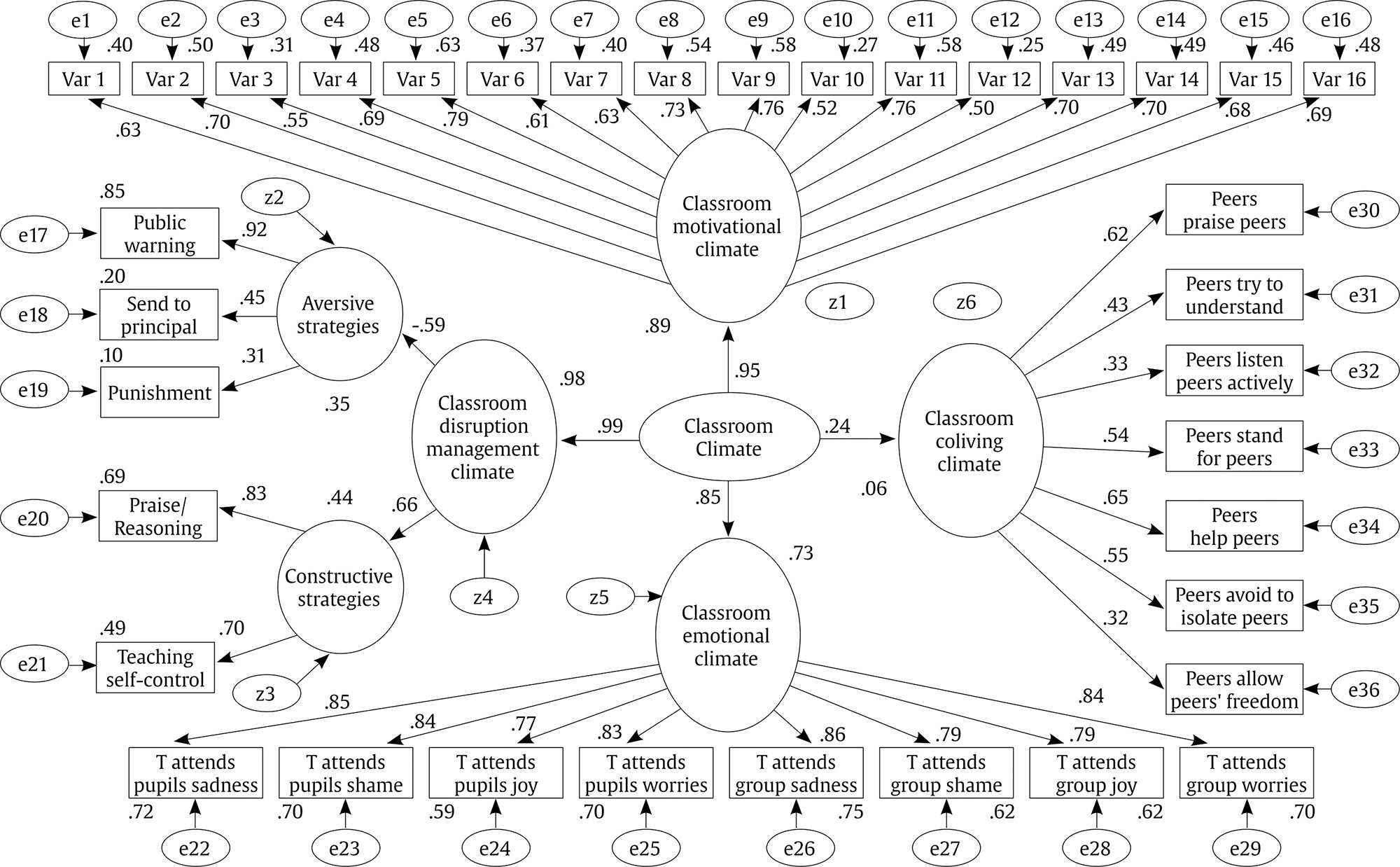 Cross-validation Analysis Results of the cross-validation analysis are displayed also in Table 1 (CFA-2 CV). It shows that, except for the statistic χ2, which was significant, the rest of values shows adequate goodness-of-fit indices according to the recommended cutoff values. Multi-group Analyses by Country The results of the multi-group analyses by country are displayed in Table 1 too (CFA-3). It shows that the statistic χ2 was significant as well as the χ2/df ratio again, probably due to the big sample size, but the rest of the values show satisfactory goodness-of-fit indices according to the recommended cutoff values. Table 1 Goodness of Fit Statistics for Each Analysis of the Model Tested   Note. CV = cross-validation; MG = multi-group; CR = Costa Rica; SP = Spain. Multi-group Analyses by Sex Results of the multi-group analyses by sex are also displayed in Table 1 (CFA-4). It shows that the statistic χ2 was significant as well as the χ2/df ratio again, probably due to the big sample size, but the rest of the values show satisfactory goodness-of-fit indices according to the recommended cutoff values. Multilevel Analysis Results of the multi-level analysis are displayed in Figure 4. Interclass correlations rank from .18 to .44 (M = .29). They show that in all cases there is an important amount of variance that depends on the classroom level, supporting the multilevel analysis. Fit statistics show that, except the χ2/df ratio, fit indexes were well inside the limits that allowed the model to be accepted. Besides, all the factor loadings at the student and classroom levels are similar and significant. In both cases, CMC, DMC, and CEC, which depend on teachers’ action patterns, are the main indicators of CC, whereas CCC is significant but much lower, as it had happened in the previous confirmatory factor analysis. Path Analyses Before examining path analyses, it must be noted that the CCC was skipped in path analyses 1 to 4 due to its low weight as an indicator of classroom climate in CFAs. Figure 5 shows the standardized estimates of path-model 1 and Figure 6 those of path model 3, and Table 2 the percentage of variance explained, and the fit statistics of all path analyses. In all cases, chi-square is significant, probably due to sample size, but the quotient χ2/df and the remaining fit indexes are well inside the limits that allow the model to be accepted. As for the cross-validation analysis, the results are pretty similar, with two fit indexes (χ2/df and RMSEA) improving slightly in some cases. Besides, fit does not decrease even if restrictions of parameter equality are imposed. Considering the amount of variance explained, CC explains 86%, 13% more than if CMC, DMC, and CEC are used together as predictors (73%). Table 2 Path Analyses. Costa Rica Sample. Percentage of Variance Explained and Goodness of Fit Statistics for Each Set of Predictors and Criteria  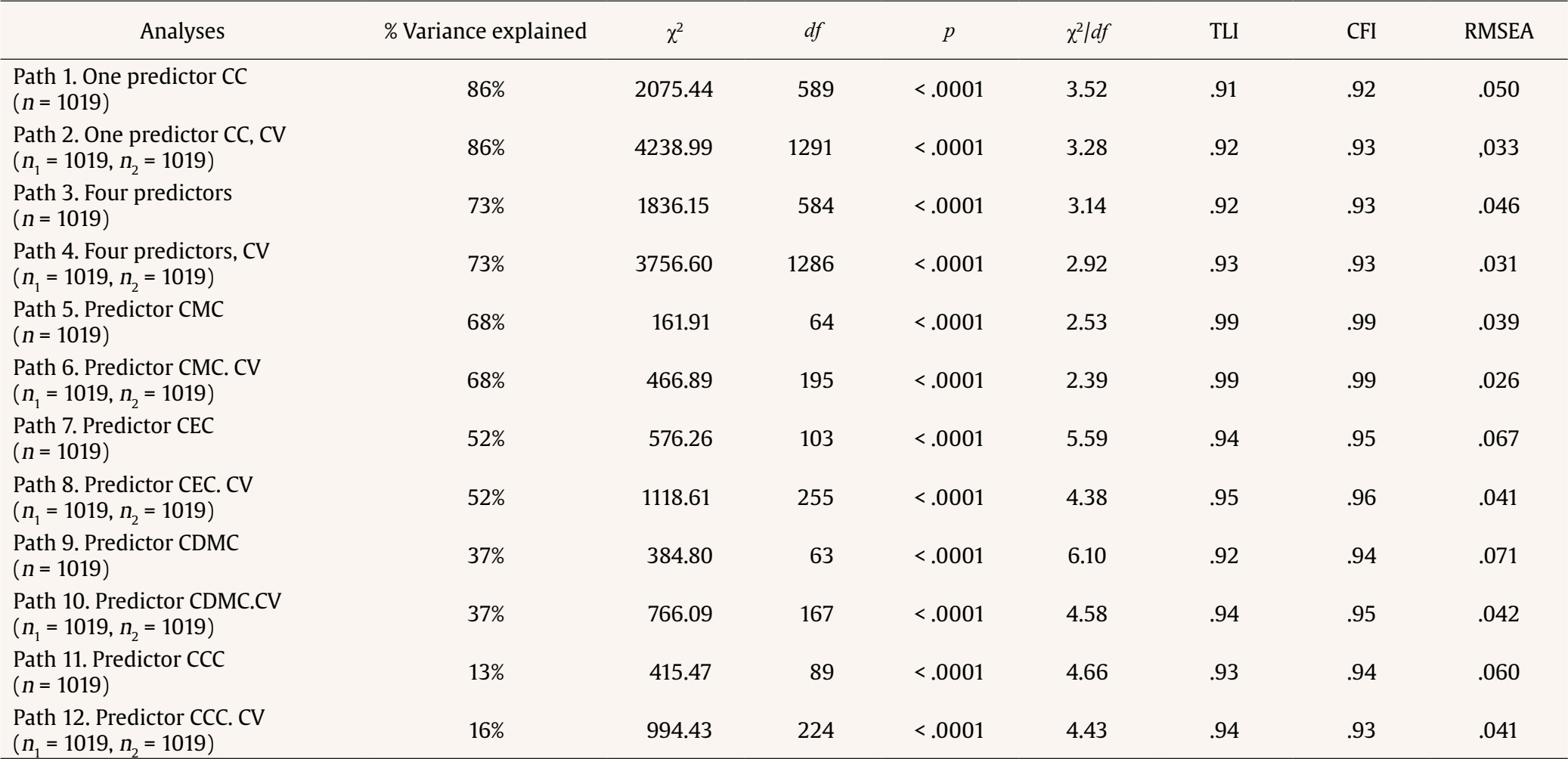 Note. CC = classroom climate; CV = cross-validation; CMC = classroom motivational climate; DEC = classroom emotional climate; CDMC = classroom disruption management climate; CCC = classroom co-living climate. Figure 5 Attribution of Classroom Climate Effects on the Student to Teacher. Standardized Measurement and Prediction Weights, and Variance Explained.   Note. Var = variable. Figure 6 Attribution of Classroom Climate Effects on the Student to Teacher. Standardized Measurement and Prediction Weights, and Variance Explained.  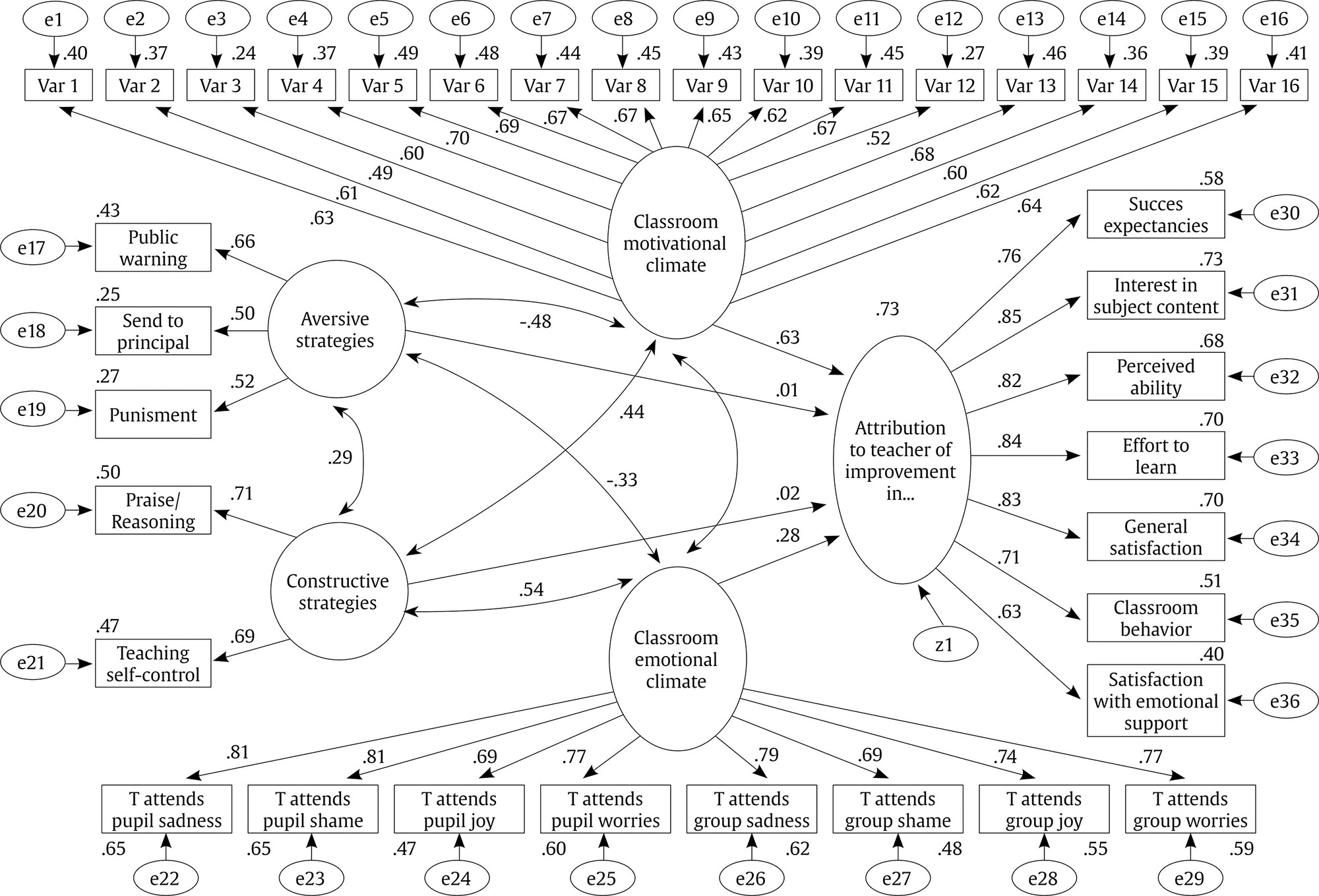 Note. Var = variable. As for the percentage of criterion variance explained by each climate when it is the only predictor (paths 5 to 12), the lower percentage, as expected, corresponds to classroom coliving climate (13 and 16%). Concerning the components of the classroom disruption management climate, they did not have a significant weight in Paths 3 and 4 when they were combined with classroom motivational and emotional climates. However, they explain a 37% of criterion variance when considered alone. Finally, the classroom motivational climate explains 68% and the classroom’s emotional climate explains 52%. The classroom motivational climate explains most of the variance, being the most important component of CC. In the introduction of this paper it was stated that there was no empirically validated and universally accepted model that allowed identifying the type of teachers’ action patterns that shape classroom climate. However, filling this gap was important, first because CC is supposed to affect students’ achievement motivation, emotional well-being, social behavior, learning, and performance among other characteristics; second, a model can serve as a basis for developing instruments for assessing and diagnosing which patterns each teacher should pay attention to; third, if a model is validated, it may help to focus educational interventions at the classroom and school levels, helping teachers reflect on the adequacy of the action patterns that configure the CC of their classrooms and change them if necessary. Therefore, our main objective was to start to fill this gap. The contributions of this study have been achieved in several steps. First, a working model of CC is presented integrated by four components or sub-climates: classroom motivational climate, disruption management climate, classroom emotional climate, and classroom coliving climate. Evans et al. (2009) had suggested that CC was integrated for the first three climates and Alonso-Tapia et al. (2019)had suggested the need to add the fourth. In previous works, instruments for assessing each climate had been developed and validated, supporting its specific sub-model. The second step has allowd us to achieve two goals simultaneously. On one side, the statistical analyses carried out have been a replica of previous studies with different samples in which the structure of each sub-climate had been validated. On the other side, the analyses have allowed the validation of the CC model. According to the results, CMC, DMC, CEC, and CCC can be considered components showing up in the CC to different degrees. From a statistical point of view, the model showed a good fit in different samples from Spain and Costa Rica and both genders. Nevertheless, when comparing the variance of CC components explained by CC, the classroom coliving climate (CCC) is a less good indicator of CC than CMC, DMC, and CEC. This result was not unexpected, as these climates depend on teachers’ behaviors, while the CCC depends on interactions between peers. However, this fact suggests focusing on climates depending on teachers’ action patterns to diagnose CC. Nonetheless, the low relation of CCC with the rest of the components of CC does not imply that it is not important for the student’s well-being, as shown by Alonso-Tapia et al. (2019). It only implies that it depends more on the quality of students’ interactions among themselves than with the teachers. The third step implied testing, through multilevel analysis, whether the CC model was similar for students and classrooms. This was the case. However, the fact that classroom level contributes to explaining part of the variance of the scores implies that teachers do not use the set of action patterns configuring CC to the same degree. This fact suggests that the quality of CC perceived by each group of students varies depending not only on the personal characteristics of each student but also on the group characteristics to which they belong. The fourth step implied the external validation of the CC model. The results of the path analyses have shown, first, that “the whole is more than the sum of its parts”. The construct CC refers to a phenomenon perceived by students as responsible for their improvement in the variables configuring the criterion variable to a greater degree than if CMC, DMC, and CEC are used in parallel, and not considered indicators of CC. This result is very important in its relevance for evaluating the quality of teachers. However, it is necessary to focus on the profile of scores obtained in the questionnaires used for assessing each specific climate to help them. CC assessment is made by children and averaged to give teachers a score of their professional quality and a profile defining its characteristics, compared with the average scores of other teachers. Both types of information contribute to helping teachers to become aware of the teaching patterns that should be changed to improve their way of teaching and managing the classroom. The results of the path analysis in which CMC, DMC, CEC, and CCC are used as independent predictors have shown that all dimensions of CC have to be paid attention to even if, due to its mutual relations, its role can be obscured when combined. Depending on the patterns to change, research provides information about what to do. For example, Lazowski and Hulleman’s (2016) meta-analysis shows different types of intervention to focus on components of CMC. Gregory and Fergus (2017) make a similar contribution to DMC, Murphy (2016) to CEC, and Son and Padilla Walker (2020) to CCC. However, even if interventions are addressed to teachers’ action patterns configuring each specific climate, the evaluation of its impact should consider the variations in CC. The reason this has to be considered is that each change in a climate seems to interact with other climates producing on students a greater effect than the specific change observed in itself. The present study has limitations. The main limitation is that the external validation of the CC model has been indirect through the students’ attribution of perceived changes to teachers. This limitation, however, points to two future research lines. First, longitudinal interventions on components of CC followed by the assessment of changes not only of the specific changes but also of CC are necessary. Second, it is necessary to identify variables at the teacher- and school levels, probably related to school climate and teachers’ knowledge and motivation, to understand potential differences in CC among teachers and schools as, for example, Alonso-Tapia and Ruiz (2022)in a study complementary of the present one and have started to do. In summary, the main contributions of this paper are three:
Besides, the instruments that make the model operational offer the possibility of profiling the teachers’ action patterns configuring each particular climate for focusing educational interventions. Conflict of Interest The authors of this article declare no conflict of interest. Cite this article as: Alonso-Tapia, J. & Ruiz-Díaz, M. (2025). Classroom climate: Empirical validation and educational implications of a conceptual model. A multilevel study. Psicología Educativa, 31(2), 129-139. https://doi.org/10.5093/psed2025a19 References |
Cite this article as: Alonso-Tapia, J. and Ruiz-Díaz, M. (2025). Classroom Climate: Empirical Validation and Educational Implications of a Conceptual Model. A Multilevel Study. PsicologĂa Educativa, 31(2), 129 - 139. https://doi.org/10.5093/psed2025a19
Correspondence: jesus.alonso@uam.es (J. Alonso-Tapia).Copyright © 2025. Colegio Oficial de la Psicología de Madrid


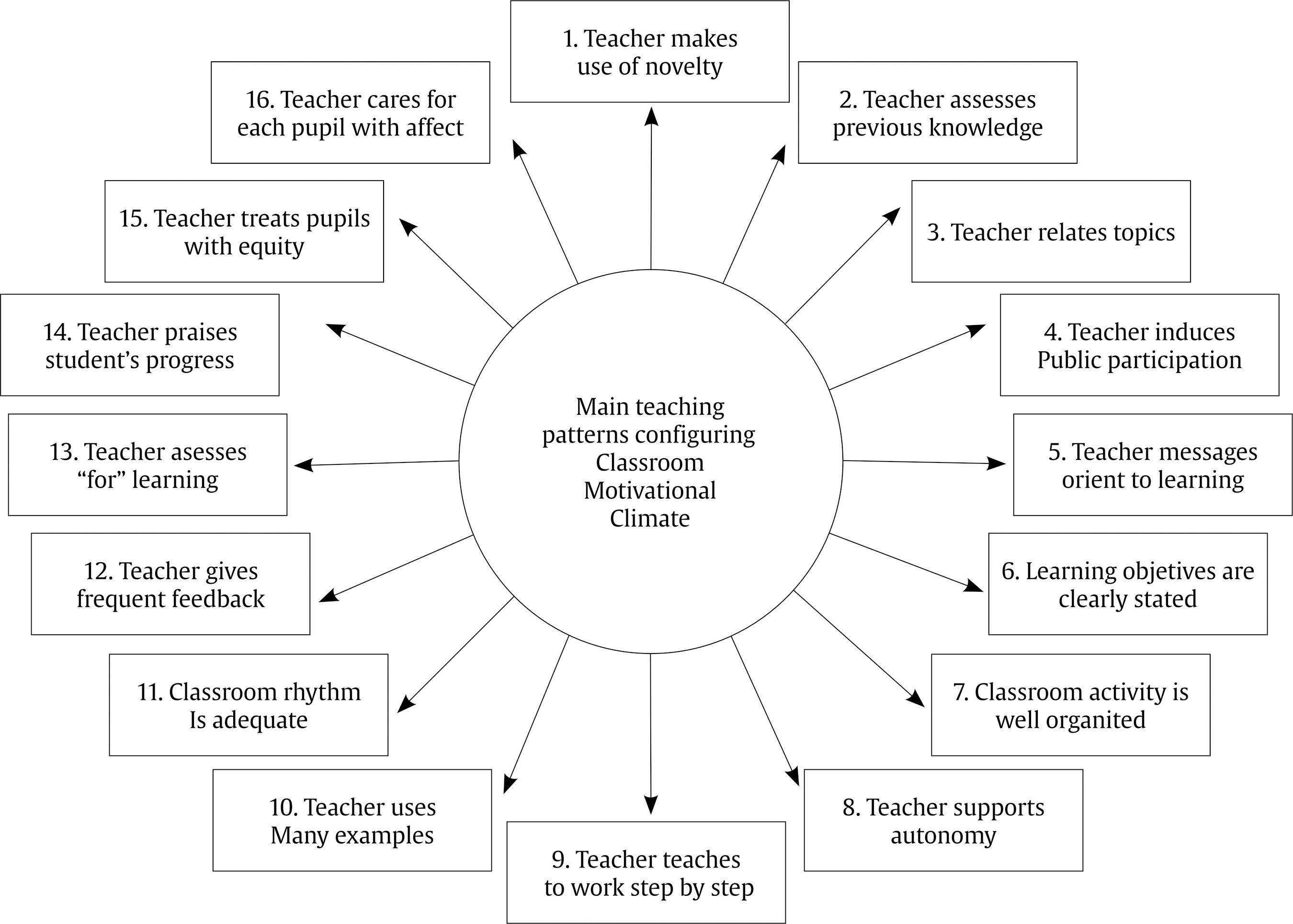







 e-PUB
e-PUB CrossRef
CrossRef JATS
JATS




